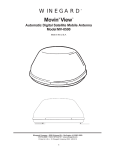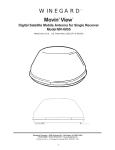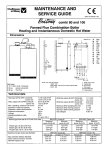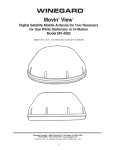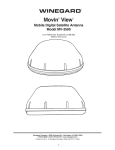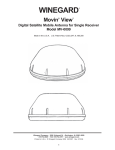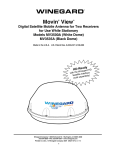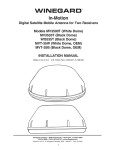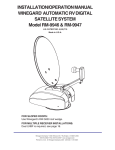Download Winegard Movin' View MV-4005 Specifications
Transcript
® WINEGARD TM Movin’ View Digital Satellite Mobile Antenna Models MV-2222/MV-1111 Made in the U.S.A. U.S. Patent Nos. 6,023,247; 6,188,300 Winegard Company • 3000 Kirkwood St. • Burlington, IA 52601-2000 319/754-0600 • FAX 319/754-0787 • www.winegard.com Printed in U.S.A. © Winegard Company 2001 2451021 Rev. 1/06/03 1 Introduction/How Does Digital Satellite TV Work? Introduction Congratulations! You have purchased one of Winegard’s latest developments in the mobile satellite reception product line —the Movin’ ViewTM. This system, used with your digital satellite receiver, will deliver the best reception possible using GPS (Global Positioning System) and precision gyroscopes. How Does Digital Satellite TV Work? and processing take place. For Programming information call: DISH NETWORKTM - 1-800-333-DISH (1-800-333-3474) DIRECTV® - 1-800-DIRECTV (1-800-347-3288) Your new Winegard RV Digital Satellite System is an easy-to-use satellite TV reception system. Because it mounts on the top of your recreational vehicle, it goes where you go and provides quality reception of digital satellite signal in the continental United States only. Satellite programming originates from an “uplink” facility on Earth — the facility receives many signals from different sources, combines the signals digitally and transmits to the satellites. The satellites (22,300 miles above Earth) receive the uplink signal, amplify it and then transmit it back to earth in the Ku frequency band. This signal is concentrated and reflected to the LNBF* located at the “focal point” of the dish. The LNBF amplifies and converts the signal to the 950 to 2050 MHz range. The signal is then passed through a coaxial cable to the receiver where individual channel selection DIGITAL BROADCAST SYSTEM SATELLITE(S) HIGH POWER KU-BAND DOWNLINK SIGNAL WINEGARD DIGITAL SATELLITE SYSTEM ANTENNA * Low Noise Block Converter Feed UPLINK SIGNAL TELEVISION SET RECEIVER PROGRAMMING UPLINK CONTROL CENTERS DIRECTV® is an official trademark of DIRECTV, a unit of GM Hughes Electronics Corporation. DISH NetworkTM is an official trademark of EchoStar Communications Corporaton. 2 Parts Included • Tools Needed • How to Unpack About this manual — We hope this manual will provide clear instructions to install and operate the MV-2222 and MV-1111. Two symbols have been used — ! Indicates suggestions to make processes easier for you. Indicates caution should be taken! PARTS INCLUDED: 1 Radome 3 base mounting feet 1 Power switch 1 Demultiplexer DC passive 1 Demultiplexer DC block (MV-2222 only) 2 Wall plates (white & brown) 1 Surface mount bracket 2 Cable clamps 1 Cable entry plate 1 large yellow spade connector 2 small red spade connectors All required screws and washers 1 base with electronics, dish, stacked LNBF 1 tube silicone TOOLS NEEDED FOR UNPACKING & INSTALLATION: 1/2” Open end wrench Crimping tool for coax connections Crimping tool for electrical connections Small blade screw driver Pliers Sealant (consult RV manufacturer for proper type for your roof material) 7/16” open end wrench Level Drill w/3/4” bit 1-1/4” hole saw (if mounting switch in wall) 5/16” Socket for roof screws 1/8” Allen wrench LIFT UNIT STRAIGHT UP UNPACKING THE UNIT 1. Open box and remove packing material. ! If using knife to open carton, BE CAREFUL. Do not cut the dome on the unit. 2. Lift unit out of box vertically. Do not turn box and “roll” out, or turn upside down to remove. USE 2 PEOPLE when removing the unit from the carton. 3 Installation Diagram GPS ANTENNA FIGURE 1 SWITCH LOCATION ADJUSTABLE BASE FOOT EL MOTOR HEYCO® CONNECTORS POWER SUPPLY LEVELING SCREW COUNTERWEIGHT LEVELING SCREW FRONT OF VEHICLE ! REAR ADJUSTABLE BASE FOOT s ire tie w e v t Remong moun holdi LEVELING SCREW REAR BASE FOOT MUST DIRECTLY FACE REAR OF VEHICLE AZ MOTOR ADJUSTABLE BASE FOOT REFLECTOR S:\PART-NO\1021P4 4 DVB Installation Installing unit on roof of vehicle — ! 6. On each foot, screw the flange nut to the base of the leveling screw on the mounting foot, flange up. Place rubber washer, with the rubber side up, on the nut, Figure 2. Push mounting foot under base. Push foot screw through the base and tighten lock nut to secure foot to base. Be sure the base feet are pointing away from the base. Base feet will be removed later during install. Install in DRY conditions only! IMPORTANT! Do not install this system in the rain, or under any wet conditions. Moisture may affect electronics and void your warranty! 1. For best performance and to reduce signal acquisition time, park vehicle on a level surface. FIGURE 2 2. Select a level spot on your roof for installation. • The unit should be no more than +/-1° off level. • Be sure no roof-mounted equipment is blocking the satellite “line of sight.” • You will need to decide where the wires will enter the vehicle. A coax and an 18 gauge power wire will need to be placed in the vehicle. The power wire will go to the nearest +12 VDC power source; the coax will be routed through the demulitplexer to your satellite receiver. These wires should be hidden. LEVELING SCREW MOUNTING RUBBER WASHER FOOT FLANGE NUT (FLANGE UP) 7. After selecting location for unit (see number 2), put the unit on the centerline of the coach. REAR MOUNTING FOOT MUST FACE DIRECTLY OFF REAR OF VEHICLE, Figure 1. There is a 30 foot power cord and 30 foot coax cable going through the Heyco® connectors on the base. 3. Remove screws holding dome to base and remove dome. Place dome in safe spot to avoid damage. Place base on vehicle roof in the location selected. 4. Remove wire ties used for shipping. There are three; one on each side of the reflector and one at the the rear of the reflector holding down the counterweight. See Figure 1, page 5. Placing the rear base bracket on the centerline, facing the rear of the vehicle, will center the unit. 5. Determine which programming you will be using. This will determine how you set your switches. 8. Using the chart, Obstruction Ht. Unit Clearance determine the 8” .......................................... 4” minimum distances to 10” ................................... 11.5” other equipment. 12” ...................................... 19” Measure these 15” ...................................... 32” distances as demonstrated in Figure 3. For DISH NetworkTM set switches to 119°. For DIRECTV® set switches to 101°. FIGURE 3 For ExpressVu® set switches to 092°. OBSTRUC TION UNIT BASE If you have trouble seeing the numbers, try using a magnifying glass! 5 Installation ROOF INSTALLATION, continued GPS installation — 9. Place the unit on the roof in its permanent location and mark around the base bracket, Figure 4. (Make sure the rear adjustable base foot is directly facing the back of the coach.) The GPS antenna is pre-wired and has a 3 foot cable running through one of the Heyco® connectors. When deciding where to place GPS antenna, DO NOT SECURE! After wiring the receiver and initializing your system, you will need to test the system (“Initializing and replacing dome” on page8). FIGURE 4 Determine location for GPS antenna. It is recommended you place the GPS antenna between unit base and side edge of vehicle, 90° from rear mounting bracket, Figure 6. The recommended location for the GPS antenna is based on having a level location and a clear view of the sky. If another location, further from the base, is desired, loosen the Heyco connector and pull out additional wire in the base. You must re-wrap and re-tie the GPS cable inside the dome to prevent interference with the LNBF. Failure to do so will result in malfunction! Tight Heyco connectors when done. 10. Clean roof area where the base feet will be attached to the roof. Do not erase your marks! 11. Put approved sealant in the area under the base feet. Place base foot on top of the sealant and screw down using (2) #10 screws (provided) for each base foot. 12. Unscrew the locknuts in the base and remove the base from feet. Put the other (4) #10 screws into the roof through the remaining holes in the base feet. 13. After all base brackets are secured to roof, put sealant on top of foot and screws. Place base on leveling screws located on base feet and install nut and rubber washer on leveling screw. IMPORTANT! The GPS must be located away from obstructions on roof of vehicle and other obstructions such as trees, tall buildings, etc. You must have a clear view of the sky for proper operation. FIGURE 6 FIGURE 5 LEVELING SCREW/FLANGE 123456789012345678901234567890121 123456789012345678901234567890121 123456789012345678901234567890121 BASE EXTERIOR 123456789012345678901234567890121 123456789012345678901234567890121 123456789012345678901234567890121 FOOT 14. Leveling the base is done by tightening or loosening the flange nut under the base, Figure 5. Use an electronic level to adjust base so there is no more than +/- 1° off level in all directions. Place level on base of unit if possible. (If your level will not fit inside the base plate, place on outside edge.) Level front to back and side to side. Raise and lower by adjusting flange nut under base. After leveling base, secure inside base with rubber washer, rubber side down toward base, and lock nut. REAR MOUNTING FOOT 6 Installation • Wiring Cable entry installation — INSTALLATION 1. Decide the best location for the cables to enter the vehicle, and the location of the switch and receiver (see “Installing the switch and receiver” below.) Drill a 1/2” hole in the roof, push wires inside. Make proper connections (remember you must have filtered +12 VDC power source). 1. Decide the location of the power on/off switch. The switch should be close to both the voltage filter and the +12 VDC power cable coming from the MV-1111/ MV-2222. Be sure the switch is turned off before you begin! See diagram at the bottom of this page. Wall or panel mount: Drill 1-1/4” hole, pull wires through wall or panel. Surface mount: Determine location and direction of box. Mount box feed wire into one of the box openings. Select plate cover (brown or white provided) and snap the rocker switch into the switch plate. Be sure switch is off! IMPORTANT! CHECK POLARITY MARKED ON THE DC VOLTAGE FILTER TERMINALS. 2. Connect the +12 VDC power wire and ground wire from vehicle to the 12 VDC Voltage Filter terminals labeled “IN”. See diagram. Connect a power wire to the + and - (minus) terminals labeled “OUT” on the DC Voltage Filter. 3. Connect the ground wire from the MV-1111/MV-2222 and the ground wire coming from the DC Voltage Filter “OUT” together using large yellow spade connector. (Black wire from MV unit and ground wire coming from the - (minus) on the DC Voltage Filter’s “OUT” terminal.) See diagram. 4. Connect yellow spade connector to silver spade on switch. 5. Connect red wire from MV unit to a small red spade connector. 6. Connect red spade connector to center spade on switch. 7. Connect +12 V wire from the DC Voltage Filter + “OUT” terminal to a small red spade connector. 8. Connect red spade connector to isolated spade on switch. 2. Place cable-entry plate over hole and cables. Screw in place. Seal plate and screw holes with approved sealant (not included). FIGURE 7 CABLEENTRY PLATE CABLE CLAMP EVERY12”-16” 3. Depending on the length of the cable on the roof, you may need to use cable clamps or wire ties (not provided) between the unit and your cable-entry plate. Clamping the cable every 12”-16” should eliminate any unnecessary cable movement, Figure 7. INSTALLING THE POWER SWITCH WINEGARD 12 VDC POWER FILTER This +12 VDC Voltage Filter is included to prevent problems that may be present in the power source for your domed satellite system. The DC Voltage Filter must be mounted INSIDE the vehicle. It is not designed for exterior installation, and is not weatherproof. INSTALLING THE POWER SWITCH DIAGRAM STEP 2 + POWER IN IN 12 V BATTERY STEP 3 & 4 DC VOLTAGE FILTER STEP 2 + OUT POWER OUT - ON/OFF ROCKER WITH LIGHT (SHOWN IN OFF POSITION.) STEP 2 TWO BLACK GROUND WIRES 1 FROM DC POWER FILTER 1 FROM MV-1111/2222 STEP 7 & 8 STEP 5 & 6 MV-1111/2222 RED POWER WIRE FILTERED +12 VDCFROM DC POWER FILTER NOTE: The DC Voltage Filter contains an internal 7.5 AMP replaceable automotive type fuse to protect the satellite unit and the filter. If the DC Voltage Filter is installed incorrectly (ie. positive and negative reversed, or positive wires are shorted to ground) the internal fuse may blow, resulting in no DC output. If you must replace the internal fuse in the DC Voltage Filter, first correct any problems. 7 Installation • Wiring Connecting the receiver — Connecting two receivers MV-1111 Domed Automatic/MV-2222Tracking System Connecting first receiver: Connecting one receiver 1. Connect the coax cable from the roof to the “IN” input on the splitter (SP-2052). Connect a coax cable from one of the “OUT” ports or jack on the splitter (SP-2052). Connect other end of this cable to the “input” on the DC PASSIVE D575p demultiplexer. 2. Determine primary receiver. The primary receiver is the one used most often. 3. Connect a coax cable from the “satellite receiver” output on the DC PASSIVE D575p demultiplexer. Connect the other end of this cable to “Satellite IN” on the primary receiver. 1. Mount the DC Passive D575p demultiplexer in the same cabinet as your receiver. 2. Connect the coax cable from the roof to the “input” on the DC Passive D575p demultiplexer. Connect a coax cable from the “sat receiver” on the DC Passive demultiplexer. Connect other end of this cable to “satellite in” on receiver. WIRING ONE RECEIVER NOT USED Connecting the second receiver: 4. Connect a coax cable from the other “OUT” output on the splitter (SP-2052). Connect the other end of this cable to the “input” on the DC BLOCK demultiplexer. 5. Connector a coax cable from the “receiver” output on the DC BLOCK demultiplexer. Connect the other end of this cable to “Satellite IN” on the secondary receiver. INPUT D575p DEMULTIPLEXER SAT RECEIVER SATELLITE IN WIRING TWO RECEIVERS NOT USED INPUT D575p DEMULTIPLEXER SAT RECEIVER Initializing & replacing the dome after connecting the receiver(s) — 1. Park vehicle where it is free of all obstructions and with a clear view of the satellite. 2. DO NOT MOVE VEHICLE during the first initialization. Power up unit, turn on receiver. FOR THE FIRST TIME ONLY, the unit may take up to 10 minutes to initially find the satellite signal. The GPS is also initializing at this time. After the GPS initializes, the unit will begin searching for the correct satellite. 3. If the GPS does not initialize at this time, turn off the unit. You may need to move the GPS antenna to a different location on your roof. After moving the GPS, DO NOT SECURE TO ROOF. 4. TEST YOUR SYSTEM BEFORE SECURING THE GPS ANTENNA. Make sure the TV and receiver have the correct satellite. 5. After correct satellite is found, secure GPS antenna by removing adhesive backing and securing to roof. 6. Tighten Heyco connectors and apply bead of silicone around the connector where the exterior hex nut touches the base, and around the cables where they enter the exterior of the Heyco connector. Before securing the dome, fill ovals in rubber gasket with silicone and apply silicone to screw threads. SATELLITE PRIMARY RECEIVER OUT IN SP-2052 DEMULTIPLEXER DC BLOCK INPUT RECEIVER OUT SECONDARY SATELLITE How to apply silicone — HEYCO CONNECTOR APPLY SILICONE BEAD AROUND COAX ON OUTSIDE OF DOME APPLY SILICONE BEAD AT BASE OF HEYCO ON OUTSIDE OF DOME FILL SCREW THREADS WITH SILICONE BEFORE INSERTING FILL OVAL WITH SILICONE 8 Operation Your new MV-2222/1111 features: • GPS technology • Fast signal acquisition times • Easy “one-button” operation • Ability to toggle between satellites using remote control, if subscribing to multisatellite programming • Low maintenance • Compatible with continental U.S. digital satel lite receivers • Winegard warranty • MV-2222 features precision gyroscopes To operate your system — NOTE: For Model MV-1111 vehicle must be parked. 1. Turn on receiver and television set. This unit will not operate unless receiver is on. Be sure your TV is turned to channel 3 or 4. 2. Turn your +12VDC tracking power switch to ON position. 3. Allow up to 3 minutes for signal location. Satellite signal acquisition will occur with normal operating conditions. For Model MV-2222, signal acquisition time is faster if the vehicle is going in a straight line, or stopped. NOTE: Acquisition time will be longer if the vehicle has traveled more than 600 miles without the unit in use. If you have traveled this distance without using the unit, signal acquisition may take up to five minutes. 4. If you do not have a signal after three minutes, be sure there are no obstacles preventing signal acquisition. (Trees, hill, buildings or other structures can block the signal.) Move to an open area so your system can “see” the satellite signal. 5. Signal interruption occurs while traveling when the line of site to the satellite is blocked. This corrects itself when blockage is cleared. The amount of time it takes your TV picture to recover will be dependent on the receiver model. 6. If you do not have signal, see Troubleshooting, p. 10. * If vehicle does not move for 6 minutes or more, the MV-2222 will go to SLEEP MODE. It will remain on the last selected satellite. Moving vehicle will cancel SLEEP MODE and unit will resume tracking mode. To toggle between satellites when subscribing to multi-satellite programming— MV-2222 and MV-1111 will toggle between two different satellites. DIRECTV and DISH Network have programming on more than one satellite. When a channel is selected on the remote control and it is not located on the satellite currently in use, the system on the vehicle will automatically move to the new satellite. (When using multiple receivers, toggling is controled by the primary receiver.) IMPORTANT! Model MV-2222 will not toggle while vehicle is moving. Toggling can only occur after vehicle is stopped for six minutes and unit is in sleep mode. DIRECTV programming 1. There is NO SETUP required for DIRECTV. When you request a channel located on a different satellite, the unit will automatically move to that satellite. 2. After signal has been acquired, 6 minutes remain to complete Check Switch test; this 6 minutes will expire with unit on or off. Consult yDISH Network receiver manual to perform Check Switch test. 3. During the Check Switch Test, the receiver will begin checking your switch by toggling between transponders. When this is completed, SW42 will appear on the screen. It will be at the top of the screen, satellite designations will be below, showing odd and even transponders. See illustration. NOTE: If a switch other than SW42 appears, or you have an X in one the of the boxes below the satellites, repeat Check Switch steps. SW42 119 119 110 110 ODD EVEN ODD EVEN DISH Network programming (DISH 500) NOTE: Once these steps have been completed, you will not need to perform this test again, unless check switch was performed on another satellite dish such as a home dish. 1. Wait for unit to acquire the satellite signal on satellite 119. Check Switch screen display 5. Your system is now set up to toggle between satellites. It will automatically move to the correct satellite when channel is selected. 9 Troubleshooting IF YOU DO NOT HAVE A SIGNAL: NOTE: The power rocker switch must be ON for the next steps. Voltage must be +12 VDC, except at the LNBF, see #2, Figure 9, page 11. 1. The signal may be blocked by trees, hills or structures. Pull into an area where no trees or buildings are in the line of sight from unit to the satellites. 6. To check voltage at connections, see Figure 9 on page 11. FOLLOW THE NUMERICAL SEQUENCE ON THE DRAWING AND CHECK VOLTAGE AT: #1. Power Supply. #2. LNBF voltage. Disconnect the coax cable from the LNBF. Check voltage from the middle wire to the shield. There should be +12 to +19 VDC. If no voltage is present, make sure receiver is on and check for +12 to +19 VDC at ends of gray coax cable (remove at box junction). #3. ‘Mini-cable’ connection voltage at Control Box. #4. Coax cable at Control Box going to Heyco connector. 2. Check your +12 VDC power switch. Make sure it is in the ON position. 3. Check your connections. The receiver must be connected to the power and coax connected from receiver to the satellite dish. Check demultiplexer connection. 4. Check your power supply. The +12 VDC power supply must be hooked up. Check for +12 VDC on the roof at the connector. 5. Is the rear adjustable base bracket facing the rear of the vehicle? See Figure 1, page 4. 7. Are the dip switches in the correct position (101 or 119)? 6. Loss of signal may also be caused by snow on roof of vehicle. 8. If the unit still does not have a signal, power off and power back on. PROBLEM SOLUTION Signal strength screen meter shows some signal strength, but constantly moves up and down, and is never locked on satellite. Unit continues to move, but never finds any signal. Check your power voltage. You may have dirty power. You must have a minimum of 12 VDC to power the stacked LNBF. If the LNBF shows no signal strength, the unit will move and operate, but you will not be able to lock onto a signal. Have signal strength on the even or odd transponders, but not on both transponders. Demultiplexer is not hooked up properly for stacked IF LNBF system, see page 7-8. The unit continues to move and the signal strength screen shows that it is finding the satellites, but will never lock onto any satellite. Continues to search. Be sure the switches are set on the correct numbers — see page 5, step 5. The unit moves around in circles, then points off the front of the coach. The GPS is not acquiring a signal. The unit moves in circles and does not find the satellite, then begins to make grinding noise. Power unit off, then on. Check switches to make sure they are set correctly. 10 Base Diagram FIGURE 9 #4 COAX CABLE AT CONTROL BOX #3 CONTROL BOX TO LNBF #1 POWER SUPPLY (POWER WIRE, SEE DETAIL) HEYCO CONNECTORS EL MOTOR GPS ANTENNA POWER SUPPLY CONTROL BOX (DETAIL BELOW) #2 LNBF VOLTAGE AZ MOTOR A CONTROL BOX DETAIL s:\part-no\1021p11 11 8-PIN POWER AZ MOTOR TO LNBF EL MOTOR TO RECEIVER T DO NOT USE Specifications & Warranty Features and specifications • One button operation. • Manufactured from sturdy ABS plastic, UV protected. • GPS satellite signal acquisition. • Off-white color compatible with all vehicles. • Depending on receiver type, you can access satellites 119°, 110° or 101°. • Compact size — 32” diameter, 15” height Weight of unit - 43 lbs. Shipping weight - 59 lbs. • No user input required. • No data port required for any receiver. • Tracking greater than 30°. • Elevation range 14.5° to 74.5°; azimuth unlimited. • 30’ power cable and 30’ coaxial cable included. TWO YEAR LIMITED WARRANTY Winegard Company warrants this Winegard product (excluding receiver) against any defects in materials or workmanship within two (2) years from date of purchase. No warranty claim will be honored unless at the time the claim is made, you present proof of purchase to an authorized Winegard dealer (if unknown, please contact Winegard Company, 3000 Kirkwood Street, Burlington, Iowa 52601-2000, telephone 319-754-0600). Winegard Company (at its option) will either repair or replace the defective product at no charge to you. This warranty covers parts, but does not cover any costs incurred in removal, shipping or reinstallation of the product. This limited warranty does not apply if the product is damaged, deteriorates, malfunctions or fails from: misuse, improper installation, abuse, neglect, accident, tampering, modification of the product as originally manufactured by Winegard, usage not in accordance with product instructions or acts of nature such as damage caused by wind, lightning, ice or corrosive environments such as salt spray and acid rain. The Two Year Warranty is provided on the condition that the equipment is properly delivered with all handling and freight charges prepaid to your Winegard dealer for repair or return to our factory at the above address. Winegard dealers will arrange for the replacement or repair and return to you, without charge, the product which failed due to defective material or workmanship. WINEGARD COMPANY WILL NOT ASSUME ANY LIABILITIES FOR ANY OTHER WARRANTIES, EXPRESS OR IMPLIED, MADE BY ANY OTHER PERSON. ALL OTHER WARRANTIES WHETHER EXPRESS, IMPLIED OR STATUTORY INCLUDING WARRANTIES OF FITNESS FOR A PARTICULAR PURPOSE AND MERCHANTABILITY ARE LIMITED TO THE TWO YEAR PERIOD OF THIS WRITTEN WARRANTY. The foregoing shall be the sole and exclusive remedy of any person whether in contract, tort or otherwise, and Winegard shall not be liable for incidental or consequential damage or commercial loss, or from any other loss or damage except as set forth above. Some states do not allow limitations on how long an implied warranty lasts, or the exclusion of limitation of incidental or consequential damages, so the above limitations or exclusions may not apply to you. This warranty gives you specific legal rights and you may also have other rights which vary from state to state. Winegard Company • 3000 Kirkwood Street • Burlington, IA 52601 • 319/754-0600 Fax 319/754-0787 • www.winegard.com Printed in U.S.A. © 2002 Winegard Company 2451021 Rev. 1/06/03 12












